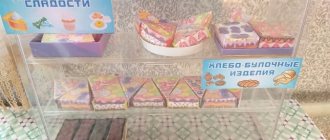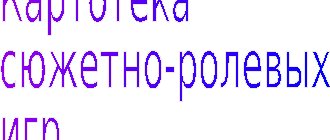Role-playing game is called the queen of children's games. Therefore, it is very important for the teacher to organize it correctly, without disturbing children’s creativity. These recommendations will help young educators and students. Before you start conducting a role-playing game in one of the age groups, pay special attention to the tasks that you will solve when working with preschoolers. These include the following:
- development of play as an activity;
- expanding the themes of children's games and deepening their content;
- acquiring positive social experience;
- using the game to educate children's groups and individual children;
- development of all aspects of the personality: movements, all mental processes (thinking, imagination, memory, speech), personality traits and character traits, strengthening and further development of the child’s emotional and volitional manifestations;
- preparing a preschooler for life in society, socializing his personality.
Before you organize and conduct a role-playing game, you need to study the features of the role-playing game, which are revealed in the works of researchers (L.S. Vygotsky, A.V. Zaporozhets, R.I. Zhukovskaya, D.V. Mendzheritskaya, A.P. Usova, D.B. Elkonin, etc.). In domestic and foreign psychological and pedagogical literature, role-playing game is considered as an activity of a special kind, which is characterized by the presence of all components of the activity: goal, motive, means, and even in some cases they talk about the result, but at the same time, each of the elements of the game activity is specific.
Having analyzed the theory, each of you must draw your own conclusions on the questions you have learned, understanding the special significance of role-playing games in the development of preschool children
When organizing a role-playing game, it is important to take into account that in early preschool age you must: select toys that allow you to develop games in the family, home, kindergarten, “drivers”, “trip”, “train”, “at the doctor”, “shop” ", etc. Pay special attention to their accessibility to children and storing them in play corners within the child’s field of vision, stimulating his play intentions.
In older preschool age, it is necessary to assemble toys by theme (for playing hospital, post office, astronauts, school, library, etc.) Prepare ready-made sets consisting of the most necessary attributes and toys, additional gaming material, and substitute items. Do not give children ready-made material, involve them in this as the game develops.
I would like to pay special attention to the following points in the method of using plot-role-playing games :
1. Select the game you will include.
2. Equipment (equipment).
3. The presence of an object-based play environment depending on age and topic.
4. Availability of a plan - outline.
Organize observation of children’s free play activities (in order to identify children’s gaming interests and skills). Familiarize yourself with the long-term plan for the development of role-playing games in this group (pay attention to the previous work done by the teacher in this direction).
1. Game selection. Start developing a plan for organizing gaming activities. At the same time, take into account the interests of the children, the level of development of game actions, the ability to develop the plot, etc. Think over and describe the content of the game. Plan possible directions for the plot. Define the game rules. Prepare all the necessary attributes for the game. Organize your gaming environment. Create a game situation for the children’s play ideas to emerge. Organize a situation of distribution of roles between children. Discuss the game concept and rules of the game. Provide direct (younger preschool age) or indirect guidance of play activities, follow the development of the plot. — Pedagogical development of a game plan, i.e. the initial stage of pedagogical design: outlining its plot, defining game roles and filling them with specific content (senior preschool age). — Familiarize children with the game plan and refine it together. - Creating an imaginary situation. Distribution of roles depending on the child’s wishes. Starting the game: create a game or problem situation, have a preliminary conversation, discuss the topic of the upcoming game, etc. Saving the game situation: use a reminder, instructions, advice, positive assessment, role interaction, etc. Completing the game: positive assessment, analysis of role-playing and friendly relationships.
Questions for analysis 1. Start of the game: how interest in the game was created; compliance of the selected techniques with the age of the children and the level of development of gaming skills. 2. Preparation for the game: created specifically; children act in an imaginary situation; is created as the game progresses. Compliance of training with the age characteristics of children. 3. What educational tasks were solved during the game? 4. Did the methods and techniques of game management help the development of the plot, gaming skills, and the formation of children’s relationships? 5. Were the principles of humanistic pedagogy implemented during the game? 6. Level of development of children’s playing and visual skills; the ability to use various means to embody the image of a hero (speech, facial expressions, gestures, costume elements, etc.). 7. Children’s passion for play, to what extent an individual approach to children was implemented. 8. The end of the game, its completion, what activities did the children move on to after the game. 9. The teacher’s assessment of children’s activities in the game, its compliance with age, management goals, and the principles of a person-oriented approach. 10. The teacher’s expected subsequent work on the development of play activities. 11. Assumptions, recommendations:
- How can you transform the object-game environment to influence the development of the plot and content of preschoolers’ games?
- Is it possible to influence children's role behavior in play, and how?
- How can children's creativity manifest themselves in play?
- What did you discover today by organizing a role-playing game with children?
- What leadership techniques do you find most effective?
- What difficulties did you encounter when managing this type of game?
- What resources have you discovered in your teaching activities?
- What has changed in your attitude towards this type of gaming activity?
The upbringing, development and consolidation of the personality qualities necessary for the future schoolchild is facilitated by such role-playing games as “School”, “Library”. They reflect the children’s ideas about school, the rules of school behavior, the teacher’s requirements, as well as their dreams and desires. When introducing children to school life, pay special attention to such phenomena as school, who are called students, pay attention to the activities of students, their relationships with each other and with the teacher, talk about the best students, arousing the desire to imitate them. Invite them into the group and tell them about interesting school activities, your favorite lesson, how the kids help those who are behind, how they spend cleanup days, participate in the work of adults, how they relax in the summer, what games they play. Conduct a conversation “Addresses of good deeds”, use works about the school. The knowledge about school acquired by children during excursions, observations, and targeted walks will help you when organizing and conducting the role-playing game “School”.
Criteria for evaluation:
- the game is appropriate for the child’s age;
- involvement in the game (number of people participating in the game);
- compliance with the game algorithm;
- emotional intensity corresponds to the intent of the game;
- features of children's behavior in the game, obedience to the rules of the game;
- degree of satisfaction with the game.
Performance indicators
- The idea arises on the initiative of the child himself, discusses it with play partners, taking into account his point of view. Formulation of the game goal and game task, stability of the concept, use of improvisation in the game.
- The main content of the game, its diversity, the relationship between objective, everyday and actions reflecting social relations.
- The plot of the game. Diversity, stability and development of the plot. The child’s ability to jointly construct and creatively develop the plot of the game.
- The playing role is indicated by a word through role-playing speech, objective actions, and facial expressions. The degree of development of the role-playing dialogue, its duration, the ability to convey the characteristic features of the character.
- Relationships, their number, stability and character.
- Game actions: degree of generalization, expansion, diversity, adequacy.
- Attitude to the rules: the ability to fulfill them with the assumed role, to monitor the implementation of the rules by other children.
- Achieving the result of the game, the ability to correlate it with the plan.
Possible risks:
- The poverty of the plots of children's games, their monotony.
- Reflection in the game of the negative aspects of the lives of adults, the subordinate position of individual children in the game, where they act as passive participants.
- Frequent conflicts regarding the distribution of roles, compliance with rules, possession of a toy, etc.
How to avoid
- Enriching children's experience by expanding, clarifying and systematizing knowledge about the environment.
- Development of gaming skills in children.
LITERATURE
- Alyabyeva E.A. Moral and ethical conversations and games with preschoolers. M.: TC Sfera, 2004, - 128 p.
- Vinogradova N.A. Role-playing games for older preschoolers: a practical guide / N.A. Vinogradova, N.V. Pozdnyakova – M.: Iris-press, 2008 – 128 p.
- Grishina G.N. Favorite children's games. - M., 1997
- Doronova T.N., Karabanova O.A., Solovyova E.V. Play in preschool age: a manual for kindergarten teachers. M.: Education of a preschooler, 2002, 128 p.
- Preschooler games. - M., 1995
- Mikhailenko N.Ya., Korotkova N.A. How to play with a child. – M., 1990.
- Novoselova S.L. Developing object-based play environment for childhood. World “Quadro” // Preschool education, 1998. No. 4.
- Polyakova M.N. Construction of a developmental environment in groups for children of senior preschool age // Preschool pedagogy. 2004. No. 1. p. 12-15.



